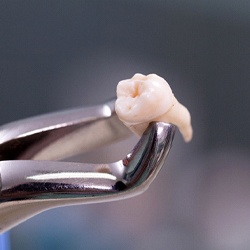Wisdom Tooth Removal – Arlington, TX
When Your Wisdom Teeth Need to Go

Between the ages of 16 and 24, many people start to notice significant pain near the back of their mouths. This is a sign that the wisdom teeth are attempting to erupt, and if they’re not extracted, they could cause even more discomfort. They could even threaten the health of your other teeth! Dr. Wardlaw has performed many wisdom tooth extractions over the years, so he’ll be more than happy to help you and your loved ones when the time comes to decide whether or not these extra teeth need to go.
What are Wisdom Teeth?

The wisdom teeth are a third set of molars meant for chewing. Early humans who maintained a diet of nuts, roots, and uncooked meat may have benefitted from these teeth in order to successfully chew a wider array of tough, rugged foods. They were also more prone to tooth loss relatively early in life, so it helped to have extra teeth erupt during early adulthood. Today, though, improved oral hygiene and state of the art dental services have made tooth loss in teenagers and young adults much rarer, and the foods we eat are softer and don’t require as much chewing. As such, wisdom teeth are no longer required for a properly functioning mouth.
Why Do Wisdom Teeth Need to Be Removed?

Most of the time, there simply isn’t enough room for wisdom teeth to erupt. As a result, they may get stuck underneath the gums. This is known as becoming impacted, and it can be a serious issue. Impacted wisdom teeth are associated with severe, persistent pain, and they can end up damaging the roots of nearby teeth. And even if your wisdom teeth do manage to partially erupt, they can contribute to overcrowding, cavities, and other oral health issues. If Dr. Wardlaw find that the wisdom teeth are causing problems or could potentially cause problems, he can let you know whether or not wisdom tooth removal is recommended in your case.
What to Expect from the Wisdom Teeth Procedure

Your mouth will be numbed for the procedure, but we can also provide sedation if you’re nervous or need help staying comfortable for the entire treatment. As for the extraction process, surgery is usually required if the tooth is still partially or completely trapped under the gums. We will make a small incision in the gums so that the tooth can be removed. In some cases, the wisdom teeth have to be sectioned, meaning they’re separated into smaller pieces; this makes it easier to remove the entire dental structure while minimizing the level of bone removal required.
Recovering from Wisdom Teeth Extraction

Normal postoperative symptoms after wisdom teeth extraction include mild to moderate bleeding, minor swelling, and some discomfort. We’ll give you instructions for managing these symptoms, which should normally fade after just a few days. For the first 24 hours after extraction, you should stick to a fully liquid diet. During the second day, you can start eating soft foods such as scrambled eggs and mashed potatoes. You can set your own pace when it comes to working your way up to the more difficult to chew foods.

